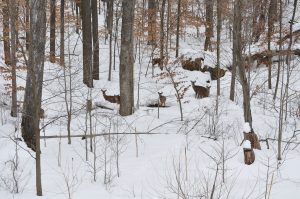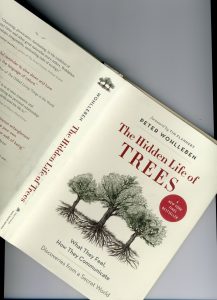My maternal great-grandfather, Elwyn Greeley Preston Sr., established for his family a summer retreat on Squam Lake in Holderness, New Hampshire. He acquired several contiguous parcels of land on Mooney Point and filled in a number of marshy areas to create firm ground on which to build camps for himself and for his four sons and their families. While converting wetlands to dry ground is rightly understood these days as an assault on the environment, EGP loved that environment. In particular, he loved the trees that grew there.
In a document drafted in 2017 for National Register of Historic Places, consultant Liz Durfee Hengen wrote,
“Preston employed extensive resources to improve the rugged, swampy terrain, regrading it and importing and distributing more than 1,000 yards of fill to smooth out the hollows and low spots and enhance the beaches. He oversaw removal of underbrush and trees to admit sunlight. (After this initial effort to open the site up, Preston was adamant about preserving the remaining trees on the site and heart-broken when the majestic pine grove he bought in 1932 was partially destroyed in a major hurricane scarcely six years later.)”
By the time my generation was cognizant of the rules and idiosyncrasies that governed life at Boulderwood (as the compound was dubbed), we knew that the one thing that was never done without considerable anguished discussion was the cutting of trees. Trees screened the houses from the water front. Trees marked key sites up and down the water front. In fact, the long dirt road that was the extension of Mooney Point Road into Boulderwood contained an abrupt jog cut in order to protect a particularly majestic pine. When EGP’s second son, my Pop, built a home in Hingham, Massachusetts, in the 1930s, he and Nannie worked with the architect to situate the home in such a way that the fewest trees possible (and no grand, ancient specimens) had to be removed.
When we moved into our current home in 2005, we had already documented the loss of a couple dozen or more trees within the area of forest on our property identified as protected and a nontidal wetland. The developer had already scraped the scraggly trees that had grown up over that last sixty or seventy years, along with the good soil that nourished them. When they finished the retaining wall that made it possible to put three houses on one side of the street, they illegally removed the modest berm build to protect the wetland. As water flooded down the new and very steep slope it pooled in the wetland, weakening trees that were unsuited to soggy feet. Some trees fell during storms; some just died and fell. Loss continued into the new few years.
We’ve planted a lot of trees since then—bald cypress, white oak, black willow, river birch, sycamore, redbud, green ash, American holly—to try to extend the woodland toward our house and fill in some of those gaps that are now nurturing an array of stinking invasives: Japanese stilt grass, Japanese knotweed, Rosa rugosa, Pawlonia.
Peter Wohlleben’s The Hidden Life of Trees, What They Feel, How They Communicate: Discoveries from a Secret World (Greystone Books, 2016) provides the science that supports EGP’s issues with chainsaws and my own gardening instincts.
Wohlleben is a forester from Germany and he does love his beech groves. Thirty-six short chapters explore the character of trees, the idea of “family” as it plays out in forests, and how clear-cutting and modern management approaches have destroyed whole ecosystems and brought death to the vitality, the communities of fungi and bacteria that once energized the soil. He reminds how slowly many trees grow—and helps the reader understand what it means to grow quickly—and too fast. He talks about sharing and communication, the exchange of moisture and sugars from root system to root system as well as the shelter proffered by the elders. Digressions take us into the lives of the “Street Kids,” those trees growing in isolation, especially in urban locals and what it means for a tree to move, and further to immigrate, relocated forcefully as a specimen in a garden or as part of a commercial plantation.
Most of all, this book helps us grasp the nature of life in these living things.
I now look out over the survivors of the trees we brought into our domain. Do those two birches that have thrived side by side enjoy each other’s company? Why did the others die? The bald cypress and sycamores have done very well. We thought we planted too many of them too close together, but who knows? I got a horrific case of poison ivy when we scavenged white pine seedlings from the woods. Whether or not that was a warning, a few of the pines have grown tall; two sickened and had to be cut down.
Through this small book—modest enough in scale to fit into a handbag or large jacket pocket—I have changed my thinking about trees, forests, and the endless generosity of that Kingdom. I listen now carefully and hope that I will be able to hear something of the story they have to tell.


